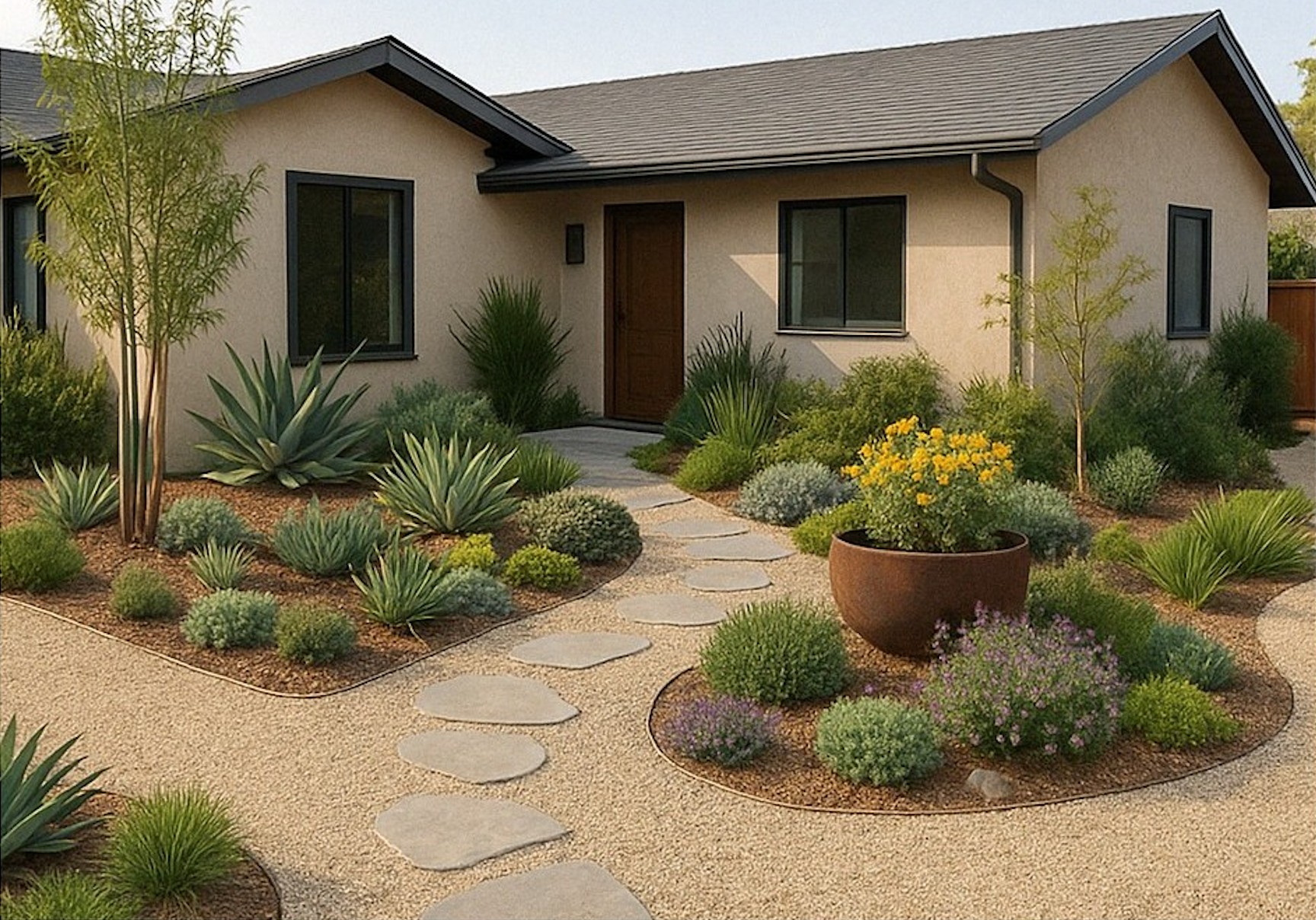Rethinking the Lawn in a Drought-Prone City
In San Diego, water conservation isn’t just a good idea — it’s a way of life. As droughts grow longer and more frequent, traditional lawns are quickly becoming a thing of the past. What used to be a symbol of suburban pride now represents one of the most water-intensive features of the home landscape. Fortunately, trading turf for smarter alternatives doesn’t mean settling for boring or barren. With thoughtful design and climate-appropriate plants, you can create a vibrant, stylish yard that celebrates San Diego’s natural beauty — and dramatically cuts your water usage.

Why Replace Your Lawn?
Grass may look green, but in San Diego, it’s one of the thirstiest and least efficient uses of your yard space. A typical 1,000 sq. ft. lawn can guzzle over 40,000 gallons of water per year — much of which evaporates before reaching the roots. Replacing turf with drought-resilient options can reduce water use by more than 70%, all while boosting curb appeal and cutting maintenance. You’ll spend less time mowing, fertilizing, and troubleshooting brown patches, and more time enjoying your outdoor space. Bonus: rebate programs like SoCal Water$mart can help offset costs of the transition.
Top Drought-Resistant Lawn Alternatives
When choosing a lawn replacement, it’s important to consider looks, foot traffic, and long-term maintenance. Here are some of the best options for San Diego yards:
- Artificial Turf: Best for play areas or dog runs. Today’s synthetic grass looks far more natural than past versions. Select infill-free or cool blade models to reduce surface heat.
- Dymondia margaretae: A hardy groundcover with silver-green foliage that tolerates light traffic and suppresses weeds. Stays low-growing and requires little water once established.
- Kurapia: A flowering groundcover that hugs the ground and blooms through summer. It needs only 30–60% of the water that turf does and naturally chokes out weeds.
- Decomposed Granite (DG): A staple of modern xeriscaping. Use DG for patios, paths, or full lawn replacement. It provides a clean, low-maintenance base that pairs beautifully with succulents and raised beds.
- Native Grasses: Carex pansa, deergrass, and native fescues offer texture, motion, and habitat value. They need little to no mowing and thrive with minimal water after establishment.
Designing a Lawn-Free Landscape
Without grass as your default filler, you can create a yard that feels more curated and personal. Start by dividing your space into functional zones: a shaded seating area, a DG pathway, a pollinator bed, or even a fire pit nook. Use boulders, dry creek beds, or raised planters to shape the layout and improve drainage.
Layer in plants with different heights, colors, and textures. For example, pair bold agaves or aloes with fine-textured grasses and trailing lantana. Mix in low-water trees like desert willow or palo verde for shade and structure. Consider lighting, too — solar uplights on sculptural plants or path lights on gravel edges can transform your yard after dark.
Cost and Maintenance Comparison
Swapping turf isn’t just a water saver — it’s a long-term investment in low-maintenance living. Here’s how common lawn alternatives compare:
- Artificial Turf: Upfront cost ranges from $8–$12 per sq. ft., but requires no water, no mowing, and can last 15–20 years with minimal care.
- Dymondia/Kurapia: Install for $2–$4 per sq. ft. These soft, living alternatives offer a more natural aesthetic and require weekly or biweekly irrigation in summer.
- DG & Gravel: Least expensive to install (around $1.50–$3 per sq. ft.) with only light maintenance — occasional weeding and top-off every few years.
- Native Plant Mixes: Initial planting and irrigation may cost more upfront, but ongoing water use is low and upkeep is minimal once plants are established.
Many drought-tolerant yards begin paying for themselves within 2–4 years through water savings and reduced yard work.
Incorporating Pollinator & Wildlife Habitat
Grass-free doesn’t have to mean lifeless. Many drought-friendly plantings actively support native bees, butterflies, and birds. Choose California natives like Cleveland sage, monkeyflower, and buckwheat. Group multiple of the same species together — this improves habitat efficiency and visual cohesion. Add a shallow dish of water or a bee hotel to complete your backyard ecosystem.
Tips for a Successful Lawn Conversion
- Remove Turf Properly: Use sheet mulching, solarization, or a sod cutter. Avoid turning the soil unnecessarily, which can stir up dormant weed seeds.
- Improve the Soil: For living groundcovers or plant beds, add compost and mulch to increase water retention and reduce erosion.
- Group by Water Needs: Create hydrozones by planting similar water-use species together. This makes irrigation more efficient and reduces waste.
- Install Drip Irrigation: Drip lines with smart timers offer precise watering, reduce evaporation, and meet San Diego’s water use regulations.
Low Water, High Style
From artistic gravel mosaics to colorful succulents and breezy ornamental grasses, San Diego homeowners have countless options to build yards that are beautiful, functional, and climate-wise. You don’t have to give up lushness or curb appeal — you just have to rethink what a successful landscape looks like in the West.
Curious about where to start? Check out our April Yard Checklist for San Diego, or subscribe to get weekly local landscaping tips and inspiration delivered straight to your inbox.
Written by Alicia Ortega, a landscape designer from North Park who specializes in Mediterranean-style yards and sustainable curb appeal. Alicia combines modern aesthetics with water-wise choices to help San Diegans fall in love with their outdoor spaces.

